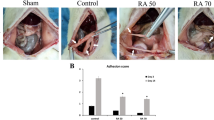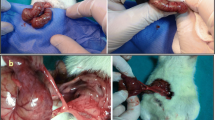Abstract
Background
Postoperative intra-abdominal adhesion is a common morbidity after laparotomy. We try to determine whether peritoneal infusion with cold saline may decrease postoperative intra-abdominal adhesion formation.
Methods
Ninety-six male BALB/c mice weighing 25-30 g were randomized into four groups: (I) adhesion model with infusion of 4°C cold saline, (II) adhesion model with infusion of room temperature saline, (III) adhesion model without infusion of saline, and (IV) sham operation without infusion of saline. Adhesion scores, incidence of adhesion, and serum cytokines were measured at postoperative days 1, 3, 7, and 14.
Results
Group I had lower adhesion scores than groups II and III (P < 0.0001). IL-6, IL-10, and TNF-α were significantly increased in the groups I, II, and III compared to group IV (P < 0.0001). IL-6 in group I was significantly decreased compared to that in group III (P < 0.0004). IL-10 in group I was significantly increased compared to that in groups II (P < 0.0001) and III (P < 0.05). TNF-α in group I was significantly decreased compared to that in groups II (P < 0.0004), and III (P < 0.05).
Conclusion
Peritoneal infusion with cold saline may decrease the degree of postoperative intra-abdominal adhesion formation.




Similar content being viewed by others
References
Ellis H, Moran BJ, Thompson JN et al (1999) Adhesion-related hospital readmissions after abdominal and pelvic surgery: a retrospective cohort study. Lancet 353:1476–1480
Chen SC, Lin FY, Lee PH et al (1998) Water soluble contrast study predicts the need for early surgery in adhesive small bowel obstruction. Br J Surg 85:1692–1694
Wilson MS, Hawkswell J, McCloy RF (1998) Natural history of adhesional small bowel obstruction: counting the cost. Br J Surg 85:1294–1298
Choi HK, Chu KW, Law WL (2002) Therapeutic value of gastrografin in adhesive small bowel obstruction after unsuccessful conservative treatment: a prospective randomized trial. Ann Surg 236:1–6
Chen SC, Yen ZS, Lee CC et al (2005) Nonsurgical management of partial adhesive small-bowel obstruction with oral therapy: a randomized controlled trial. CMAJ 173:1165–1169
Ellis H (2007) Postoperative intra-abdominal adhesions: a personal view. Colorectal Dis 9(Suppl 2):3–8
Parker MC, Ellis H, Moran BJ et al (2001) Postoperative adhesions: ten-year follow-up of 12, 584 patients undergoing lower abdominal surgery. Dis Colon Rectum 44:822–830
Kossi J, Salminen P, Rantala A et al (2003) Population-based study of the surgical workload and economic impact of bowel obstruction caused by postoperative adhesions. Br J Surg 90:1441–1444
Ellis H (1997) The clinical significance of adhesions: focused on intestinal obstruction. Eur J Surg 577:5–9
Ray NF, Larsen JW Jr, Stillman RJ et al (1993) Economic impact of hospitalizations for lower abdominal adhesionolysis in the United States in 1988. Surg Gynecol Obstet 176:271–276
Greene AK, Alwayn IPJ, Nose V et al (2005) Prevention of intra-abdominal adhesions using the antiangiogenic COX-2 inhibitor Celecoxib. Ann Surg 242:140–146
DiZerega GS, Campeau JD (2001) Peritoneal repair and post-surgical adhesion formation. Hum Reprod Update 7:547–555
Beck DE, Cohen Z, Fleshman JW et al (2003) Adhesion Study Group Steering Committee. A prospective, randomized, multicenter, controlled study of the safety of Seprafilm adhesion barrier in abdominopelvic surgery of the intestine. Dis Colon Rectum 46:1310–1319
DeVirgilio C (1999) Fibrin glue reduces the severity of intra-abdominal adhesions in a rat model. Am J Surg 178:577–580
Vrijland WW, Tseng LN, Eijkman HJ et al (2002) Fewer intraperitoneal adhesions with use of hyaluronic acid-carboxymethylcellulose membrane: a randomized clinical trial. Ann Surg 235:193–199
Oncel M, Kurt N, Remzi FH et al (2001) The effectiveness of systemic antibiotics in preventing postoperative, intraabdominal adhesions in an animal model. J Surg Res 101:52–55
Tamion F, Richard V, Lyoumi S et al (1997) Gut ischemia and mesenteric synthesis of inflammatory cytokines after hemorrhagic or endotoxic shock. Am J Physiol 36:G314–G321
Lee CC, Chang IJ, Yen ZS et al (2005) Effect of different resuscitation fluids on cytokine response in a rat model of hemorrhagic shock. Shock 24:177–181
Holmdahl L, Kotseos K, Bergstrom M et al (2001) Overproduction of transforming growth factor-beta1 (TGF-beta1) is associated with adhesion formation and peritoneal fibrinolytic impairment. Surgery 129:626–632
Decker D, Tolba R, Springer W et al (2005) Abdominal surgical interventions: local and systemic consequences for the immune system–a prospective study on elective gastrointestinal surgery. J Surg Res 126:12–18
Badia JM, Whawell SA, Scott-Coombes DM et al (1996) Peritoneal and systemic cytokine response to laparotomy. Br J Surg 83:347–348
van Berge Henegouwen MI, van der Poll T, Deventer SJH et al (1998) Peritoneal cytokine release after elective gastrointestinal surgery and postoperative complications. Am J Surg 175:311–316
Biffl WL, Moorev EE, Moore FA et al (1996) Interleukin-6 in the injured patient. Marker of injury or mediator of inflammation? Ann Surg 224:647–664
Bone RC (1996) Toward a theory regarding the pathogenesis of the systemic inflammatory response syndrome: What we do and do not know about cytokine regulation. Crit Care Med 24:163–172
van Westreenen M, van den Tol PM, Pronk A et al (1993) Peritoneal lavage promotes intraperitoneal adhesion in the rat. Eur Surg Res 31:196–201
Sortini D, Feo CV, Maravegias K et al (2006) Role of peritoneal lavage in adhesion formation and survival rate in rats: an experimental study. J Invest Surg 19:291–297
Hague BA, Honnas CM, Berridge BR et al (1998) Evaluation of postoperative peritoneal lavage in standing horses for prevention of experimentally induced abdominal adhesions. Vet Surg 27:122–126
Montz EJ, Monk BJ, Lacy SM et al (1993) Ketorolac tromethamine, a nonsteroidal anti-inflammatory drug: ability to inhibit postradical pelvic surgery adhesions in a porcine model. Gynecol Oncol 48:76–79
Siegler AM, Kontopoulos V, Wang CF (1980) Prevention of postoperative adhesions in rabbits with ibuprofen, a nonsteroidal anti-inflammatory agent. Fertil Steril 34:46–49
Holtz G (1982) Failure of a nonsteroidal anti-inflammatory agent (ibuprofen) to inhibit peritoneal adhesion formation reformation after lysis. Fertil Steril 37:582–583
Guvenal T, Cetin A, Ozdemir H et al (2001) Prevention of postoperative adhesion formation in rat uterine horn model by nimesulide: a selective COX-2 inhibitor. Hum Reprod 16:1732–1735
Replogle RL, Johnson R, Gross RE (1966) Prevention of postoperative intestinal adhesions with combined promethazine and dexamethasone therapy: experimental and clinical studies. Ann Surg 163:580–588
Risberg B (1997) Adhesions: preventive strategies. Eur J Surg Suppl 577:32–39
Grosfeld JL, Berman IR, Schiller M et al (1973) Excessive morbidity resulting from the prevention of intestinal adhesions with steroids and antihistamines. J Pediatr Surg 8:221–226
Reijnen MM, Falk P, Van Goor H et al (2000) The antiadhesive agent sodium hyaluronate increases the proliferation rate of human peritoneal mesothelial cells. Fertil Steril 74:146–151
Zeng Q, Yu Z, You J et al (2007) Efficacy and safety of Seprafilm for preventing postoperative abdominal adhesion: systematic review and meta-analysis. World J Surg 31:2125–2132
Becker JM, Dayton MT, Fazio VW et al (1996) Prevention of postoperative abdominal adhesions by a sodium hyaluronate-based bioresorbable membrane: a prospective, randomized, double-blind multicenter study. J Am Coll Surg 183:297–306
Bahadir I, Oncel M, Kement M et al (2007) Intra-abdominal use of taurolidine or heparin as alternative products to an antiadhesive barrier (Seprafilm) in adhesion prevention: an experimental study on mice. Dis Colon Rectum 50:2209–2214
Fazio VW, Cohen Z, Fleshman JW et al (2006) Reduction in adhesive small-bowel obstruction by Seprafilm adhesion barrier after intestinal resection. Dis Colon Rectum 49:1–11
Acknowledgment
This study was partly supported by the National Science Council Grant NSC 93-2314-B-002-260.
Author information
Authors and Affiliations
Corresponding author
Rights and permissions
About this article
Cite this article
Fang, CC., Chou, TH., Lin, GS. et al. Peritoneal Infusion with Cold Saline Decreased Postoperative Intra-Abdominal Adhesion Formation. World J Surg 34, 721–727 (2010). https://doi.org/10.1007/s00268-009-0378-7
Published:
Issue Date:
DOI: https://doi.org/10.1007/s00268-009-0378-7




